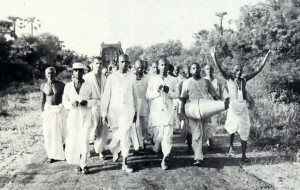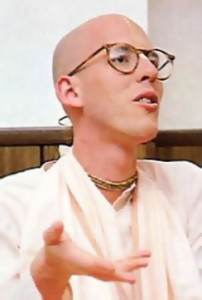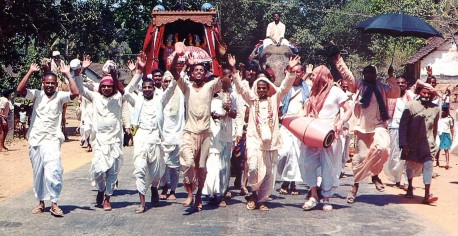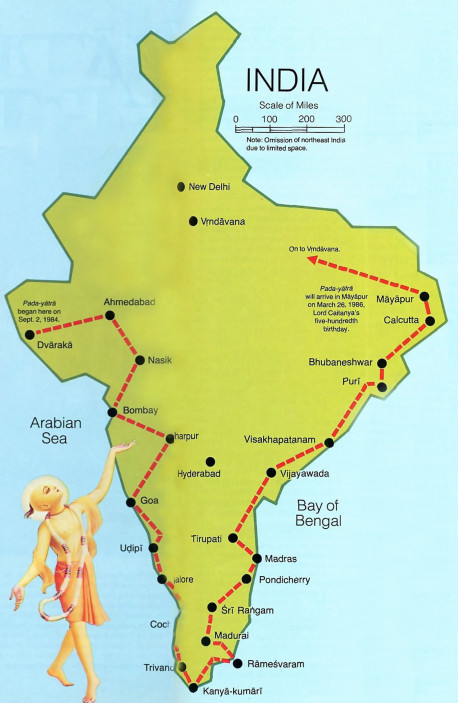A Walking Tour of Holy India
In India, going on pilgrimage to places where the Supreme Lord performed His pastimes is as popular, or more so, than sightseeing is in the West. Every year hundreds of millions of Indians journey by plane, train, bus, auto, ox cart, and on foot to ancient temples and to holy cities. The word pada-yatra (literally “walking festival”) refers to any extended walking tour of sacred places. Thus pada-yatra is an integral part of India’s honored pilgrimage tradition. Five hundred years ago, when the Supreme Personality of Godhead, Krsna, descended as Lord Caitanya to play the part of His own devotee, He performed pada-yatra, traveling on foot all over South India and Inspiring everyone to chant Krsna’s holy name. To commemorate the appearance and travels of Lord Caitanya, a pada-yatra organized by the International Society for Krishna Consciousness has been touring around the entire Indian subcontinent, visiting many of the same pilgrimage sites Lord Caitanya visited.
This special section features an article by His Holiness Lokanatha Swami, the pada-yatra’s chief organizer. His Holiness Jayadvaita Swami, another pada-yatra leader, delivers a provoking commentary on the influence of Western culture on India’s village life. His Holiness Jagatguru Swami tells us about the South Indian city of Sri Rangam and of Lord Caitanya’s historic visit there five centuries ago.
Pada-yatra’s chief organizer tells how this roundabout tour of India is a direct route to Lord Caitanya’s mercy.
by Lokanatha Swami

In 1976, Srila Prabhupada asked me to start a party that would travel in India by bullock cart to the towns and villages in India and perform kirtana [congregational chanting of Hare Krsna]. That program was successful, and Srila Prabhupada was very pleased. Then in ’77 he expressed a transcendental desire to go himself on a cart pulled by bullocks- and circurnambulate Vrndavana. From there he would continue all over India. Srila Prabhupada was very ill at the time, and the devotees serving him felt his fragile body would be unable to survive the rough treatment of the roads. Ultimately, this desire of His Divine Grace remained unfulfilled.
Then, as the five-hundredth anniversary of Lord Caitanya’s appearance approached, Srila Jayapataka Swami Acaryapada was considering traversing the same route as the one Lord Caitanya traveled. Srila Acaryapada knew I was experienced in traveling from village to village, so he wrote me about his proposal. Later on, the leading devotees approved the plan for a pada-yatra to visit the same places that Lord Caitanya had visited some five hundred years ago. I find this a matchless way to commemorate the five-hundredth birthday of Lord Caitanya Mahaprabhu.
Aims and Objectives
The main objective is to please Lord Caitanya by glorifying Him. Lord Caitanya is Krsna Himself in the role of His own devotee. There is much evidence in the scriptures that proves this fact, but even in India many people still do not know this; they take Lord Caitanya for one of the great saints. The pada-yatra is rectifying this misunderstanding by establishing that Lord Caitanya is the Supreme Personality of Godhead.
We also want to introduce Srila Prabhupada as the specially empowered representative of Lord Caitanya who fulfilled His prediction that the holy name of Krsna will be preached in every town and village in the world.
The pada-yatra is made up of devotees from all over the world. As the party travels the countryside, people see devotees from many countries and understand they represent even more devotees in their native lands. Thus the people can at once appreciate Srila Prabhupada’s glorious position. Also, Indian people who see foreigners practicing Krsna consciousness strictly and sincerely are shocked into reviving their faith and interest in their own religion and culture. Indian culture is the richest and most ancient surviving culture in the world’, but present-day Indians are misled by the allure of the Western culture, which is based on the ignorant misconception that the body is the self. Pada-yatra inspires them to take a second look at their cultural heritage.
Indian people who see so many Western devotees of Krsna joyfully engaged in Krsna consciousness are deeply impressed, because they know that these Western men and women have left the very society and value system that India is trying to imitate. In addition, we distribute thousands of books explaining the authentic understanding of the Indian spiritual traditions The people read these books and appreciate, many for the first time, the true purport of the scriptures: unalloyed devotion to Krsna, the Supreme Personality of Godhead. Then the people are inspired to change their lives by chanting Hare Krsna.
Another effect we are having is to further the integration of the Indian nation. A God-centered conception of life can keep this nation united. Without it, materialism and self-centeredness prevail, and materialistic people can never remain united for long. Krsna consciousness, on the other hand, teaches one to be selfless, to sacrifice one’s selfish interest for the sake of the greater whole. This sense of putting oneself last comes only from putting Krsna in the center. Our pada-yatra party, made up of people from all over the world, is a miniature example of this principle.
Is the Attempt Worthwhile?

Since we started on September 2 last year, we’ve gone almost three thousand kilometers, and the response throughout the journey has been overwhelmingly favorable, way beyond our expectations. We’ve reached millions. Every day thousands of people get the opportunity to realize the divinity of Lord Caitanya Mahaprabhu. In the association of His devotees they feel inspired to regularly chant the Hare Krsna mantra, the greatest prayer for deliverance in this quarrelsome age.
One man who attended our program in the evening approached me the next day, as we were leaving his village. He had been so inspired by our program that he had begun reading Srila Prabhupada’s Bhagavad-gita As It Is immediately and then finished five rounds of Hare Krsna chanting before he went to bed. This man said he had taken a vow to do this daily, and he had wanted to start the very same day. We consider this kind of response the perfection of the pada-yatra.
Another thing the pada-yatra is doing is clearing up any misconceptions rural people may have about the International Society for Krishna Consciousness (ISKCON) by giving them firsthand information. For example, some people accuse ISKCON of being an organization for rich city people. But when they see the devotees walking through the countryside, satisfied with the accommodations and food offered by the villagers and working hard to spread Krsna consciousness, they realize the devotees are genuinely interested in the welfare of all the people.
Another example: Some people think ISKCON devotees are idle hippie types. But when the people see that the devotees are happily following our four regulative principles—giving up meat-eating, intoxication, illicit sex, and gambling—and that they’re always chanting the holy name of Krsna as they walk along the road, the people can understand that this is a serious movement. Pada-yatra is gaining a good name for ISKCON.
Enthusiastic Responses
Many cabinet ministers, chief ministers, members of parliament, mayors, municipal commissioners, religionists, and scholars have received and appreciated the pada-yatra devotees. So this program is a success on many levels. Srila Prabhupada would have been very pleased with it, and his pleasure is something that really matters to us.
For the devotees of Indian origin it’s easier than for the foreign devotees. The weather sometimes gets very hot, and people aren’t used to the heat. Out in the countryside we don’t have the kind of facilities we’re accustomed to in the cities. We often have to answer nature’s call in the fields and stay in places with no real privacy. In the villages we sometimes get first-class facilities, but usually we get a big hall, and the whole party has to spend the night there with no partitions, no privacy. This is actually a very good thing, because it teaches detachment, tolerance, and humility. Krsna consciousness is meant for austerity, not soft living. Devotees are grateful for the purification and for the advancement in Krsna consciousness they’re making on this pada-yatra.
A Big Job
Obviously, maintaining a party of one hundred devotees, five bullocks, a camel, and an elephant is not going to be easy. But the hospitality in the villages is really wonderful. That is what keeps us going. In the Indian cultural tradition one is trained to receive guests—especially sadhus, or saintly persons—as if God Himself had come to your home. This is changing with the times, but it is still dominant here in the Indian villages. Our advance party goes ahead and tells the people that the pada-yatra is coming and what accommodations we’ll need. The news spreads quickly by word of mouth, and things begin to happen. The people arrange some accommodations, either in a school or a big temple, and they always feed us and usually our animals. Then there is always a nearby river or well to wash clothes and take our bath in. Sometimes we stay in dharmasalas, dormitories meant exclusively for mendicant sadhus and pilgrims.
The villagers give us other things as well. In Rajkot, Gujarat, a man donated 150 pairs of shoes. Last winter, some patron members of ISKCON sent us blankets and sweaters. One of them personally came out to meet the party and deliver his gifts of warm clothes. And from some of the ISKCON temples in India we also get regular monthly cash contributions and sometimes free books for distribution. By the mercy of the devotees, villagers, and others, help keeps trickling in in one form or another.
Longest Pada-yatra In History
This is the first pada-yatra ISKCON has organized. The Times of India, the leading daily paper, has described it as “a maha-pada-yatra,” the longest pada-yatra in history, and with international participation. It is unique in many ways, but pada-yatras are not uncommon in India Whether for economic or spiritual reasons. individually or collectively, people prefer, walking to holy places. It sometimes take them weeks, but it is a common practice. Of course, though the real purpose of a pada-yatra is to give one a chance to make spiritual advancement, politicians some times use it for political purposes. Gandhi’s 241-mile trek in 1930 in defiance of the Salt Act imposed by the British is the now famous pada-yatra in this century. A more recent attempt by another politician—a walk from Kanya-kumari, the southern most tip of India, to New Delhi—failed to give him the popularity he hoped for.
Now, ISKCON has already started two processions outside of India, in Mauritius and in Brazil, because of the success of this one in India. One of our devotees from Gainesville, Florida, spoke to me earlier this year and said he wants to start one in the United States. When I was in America two years ago, the devotees in Washington, D.C., had a chanting party on a bullock cart; it got a lot of attention from the press. Also, the devotees on the Gita-nagari farm in Pennsylvania sometimes distribute prasadam [food offered to Krsna] in the villages and towns from bullock carts. So I think there is scope for this type of program in other parts of the world.
Pada-yatra until 1996
Srila Tamal Krishna Goswami suggested to me that the pada-yatra should not stop after the festival in 1986. I completely agree. This is the best program for establishing Krsna consciousness at the grassroots level in India. My plan is to continue northwest after our annual festival in Mayapur in March 1986, all the way to Vrndavana. En route we will pass through Gaya, Benares, Ayodhya, Allahabad, the Naimisaranya forest, Old Delhi, New Delhi, and then on to Vrndavana. The idea is to reach Vrndavana by November of ’86, in time for Srila Prabhupada’s disappearance-day memorial.
Then from there we will begin a ten-year pada-yatra, returning in 1996 for Srila Prabhupada’s centennial appearance anniversary festival. This way, those devotees who could not join the present pada-yatra will still have the oppportunity to go on pada-yatra. If my Godbrothers approve and support this plan, it will not be too difficult to achieve. It would largely depend on the leaders’ realizing the enormous potential of this program for spreading Krsna consciousness. The best way to get that realization—the only way, in fact—is to participate in it for a while and experience firsthand the preaching and purifying potency of the pada-yatra program.
Join us on pilgrimage in India by joining the pada-yatra now underway. (See RESOURCES on page 22). Or attend ISKCON’s annual festival in Mayapur, West Bengal, the site of Sri Caitanya Mahaprabhu’s appearance and youthful pastimes. Every year, devotees of Krsna from around the world join together for three weeks of spiritual association at this holy place of pilgrimage. We have special group airfares, and meals and accommodations at our own ISKCON center. This year, the pilgrimage festival takes place in March. It’s a once-in-a-lifetime event, celebrating 500 years since the advent of Lord Caitanya. And you are invited to join us.
People of Pada-yatra
 Lokanatha Swami was born in Aravade, a small village in the Indian state of Maharastra. In 1971, while he was pursuing a degree in chemistry at a Bombay university, he met the Hare Krsna devotees for the first time. Srila Prabhupada and a group of his American and European disciples were holding a spiritual festival at Bombay’s Cross Maidan park, and Lokanatha attended every evening, relishing Prabhupada’s lectures and watching the Western devotees with great interest.
Lokanatha Swami was born in Aravade, a small village in the Indian state of Maharastra. In 1971, while he was pursuing a degree in chemistry at a Bombay university, he met the Hare Krsna devotees for the first time. Srila Prabhupada and a group of his American and European disciples were holding a spiritual festival at Bombay’s Cross Maidan park, and Lokanatha attended every evening, relishing Prabhupada’s lectures and watching the Western devotees with great interest.
In 1972 Lokanatha decided to join the Hare Krsna temple in Bombay. He also decided to quit school, even though his family and friends back in Aravade were at first strongly opposed. He soon received initiation from Srila Prabhupada and a few years later entered the renounced order, sannyasa. He has served as president of the Delhi temple and has traveled and lectured extensively in India and abroad. In 1976, at Srila Prabhupada’s request, he led a group of devotees from Vrndavana, just south of Delhi, to Mayapur, West Bengal, traveling by ox cart.
Lokanatha Swami is the pada-yatra’s chief organizer and has been leading the festival since its beginning in September 1983. He is well known in the International Society for Krishna Consciousness (ISKCON) for his humility and innate appreciation of Krsna consciousness. Renowned as a leader of kirtanas (congregational chanting of God’s holy names to the accompaniment of Indian drums and cymbals), he has preached effectively all over India, inspiring large crowds to join in the chanting. His presence has helped maintain the momentum of the pada-yatra.
Srila Prabhupada, shortly before passing away in 1977, expressed a strong desire to go on pilgrimage, riding in a ox cart, to all the holy places in India. That petition served as the inspiration for Lokanatha Swami, who sees the pada-yatra as his chance to fulfill one of Srila Prabhupada’s last requests.
 Jayadvaita Swami was born in Jersey City, New Jersey. He met Srila Prabhupada in 1968 at the age of eighteen. When he joined the New York temple, his first engagements were stapling pamphlets and typing. Now he is known in ISKCON for his scholarship and understanding of the Krsna consciousness philosophy. He served for many years as a senior member of the Bhaktivedanta Book Trust, editing the Bhagavad-gita, Srimad-Bhagavatam and Sri Caitanya-caritamrta. As editor of Srila Prabhupada’s voluminous writings, he deeply imbibed the formidable Krsna consciousness philosophy, as his numerous articles for BACK TO GODHEAD and his thousands of public lectures attest. He has been closely associated with BACK TO GODHEAD since its early years, most recently serving for six years as senior editor. Since the early years of the Krsna consciousness movement, Jayadvaita Swami has been known for his serious determination, sharp wit, and speaking ability. From the beginning he was a simple and renounced disciple of Srila Prabhupada. So it was natural that he eventually took formal initiation into the sannyasa order of renunciation. It was thus that he received the title “Swami” (one who is master of his senses).
Jayadvaita Swami was born in Jersey City, New Jersey. He met Srila Prabhupada in 1968 at the age of eighteen. When he joined the New York temple, his first engagements were stapling pamphlets and typing. Now he is known in ISKCON for his scholarship and understanding of the Krsna consciousness philosophy. He served for many years as a senior member of the Bhaktivedanta Book Trust, editing the Bhagavad-gita, Srimad-Bhagavatam and Sri Caitanya-caritamrta. As editor of Srila Prabhupada’s voluminous writings, he deeply imbibed the formidable Krsna consciousness philosophy, as his numerous articles for BACK TO GODHEAD and his thousands of public lectures attest. He has been closely associated with BACK TO GODHEAD since its early years, most recently serving for six years as senior editor. Since the early years of the Krsna consciousness movement, Jayadvaita Swami has been known for his serious determination, sharp wit, and speaking ability. From the beginning he was a simple and renounced disciple of Srila Prabhupada. So it was natural that he eventually took formal initiation into the sannyasa order of renunciation. It was thus that he received the title “Swami” (one who is master of his senses).
Just prior to his going to India to travel with the pada-yatra, Jayadvaita Swami served in Europe, where he directed the publication of BACK To GODHEAD in several languages. Now that he is walking with the pada-yatra, getting a rare, intimate look at the people and culture of India, he is informing-and provoking the readers of BACK To GODHEAD with frontline reporting and incisive commentary from such places as, Udipi, Ramesvaram vam, Tirupati and Madras. And there’s more to come. With India’s population being predominantly rural, the pada-yatra is affecting the lives of hundreds of millions who live in the villages. And Jayadvaita Swami, as a vital member of the pada-yatra, works to revive their God consciousness.
 Havirdhana dasa is one of the leaders assisting Lokanatha Swami on the pada-yatra program. Prior to joining the Krsna consciousness movement, Havirdhana made two trips to India “looking for something positive to do with myself.” In 1979, on his third such trip from England, his homeland, he realized Krsna consciousness was the positive alternative to the diverse occupations he had previously tried but had found unfulfilling. “I was traveling around India,” he relates, “and I had remained for some time in Rishikesh. A devotee met me there and said, ‘Come down to Vrndavana. The biggest festival of the year, Krsna’s birth day, is coming soon.’ I asked around about Vrndavana, and everyone told me it’s very nice there. So I went.”
Havirdhana dasa is one of the leaders assisting Lokanatha Swami on the pada-yatra program. Prior to joining the Krsna consciousness movement, Havirdhana made two trips to India “looking for something positive to do with myself.” In 1979, on his third such trip from England, his homeland, he realized Krsna consciousness was the positive alternative to the diverse occupations he had previously tried but had found unfulfilling. “I was traveling around India,” he relates, “and I had remained for some time in Rishikesh. A devotee met me there and said, ‘Come down to Vrndavana. The biggest festival of the year, Krsna’s birth day, is coming soon.’ I asked around about Vrndavana, and everyone told me it’s very nice there. So I went.”
In Vrndavana, the sacred place of Lord Krsna’s childhood pastimes, Havirdhana stayed at the ISKCON center, the Krishna-Balaram temple, and helped out with the festival preparations. He chanted Hare Krsna with the devotees and attended classes on the devotional science of Krsna consciousness. After the festival, he stayed on; he was becoming more and more convinced that Krsna consciousness would lead him to the Absolute Truth. Six months later he asked for initiation, thus formalizing his commitment to the spiritual path of devotion to Lord Krsna.
Although in his six years of active membership in the Krsna consciousness movement Havirdhana has held a number of posts, none of them has been as inspiring to him as pada-yatra. He has been involved with the pada-yatra since it began in September of 1984.
Says Havirdhana: “I cannot see anything else for me but pada-yatra. After we reach Mayapur, I would like to go on to Vrndavana and come around again, through Bombay and South India. The preaching impact of this program is just incredible. Every day we are reaching hundreds of people.”



Leave a Reply